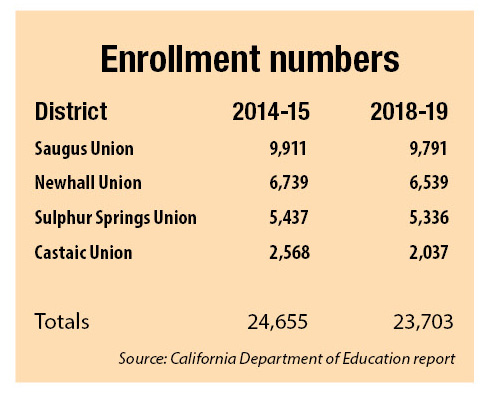California’s Superintendent of Public Instruction Tony Thurmond announced the most recent enrollment data for public schools in the state, indicating Santa Clarita Valley school districts aren’t alone in dealing with declining enrollment numbers.
The reports indicate an overall 0.8 percent decline in K-12 public school student enrollment statewide over the last four years, from 6.2 million in 2014-15 to 6.19 million in 2018-19.
And for public school districts, the decline in enrollment means a decline in average daily attendance (ADA) funding, the major backbone to most state funding for schools. For a district like the Saugus Union School District, one student in the district can account for $8,473.60 in ADA funding in the 2018-19 school year, according to officials, and that money is critical to keeping teachers hired, and, therefore, class sizes down.

“Statewide enrollment has been declining while, over the long-term, student-teacher ratios are much higher than they were maybe a generation ago,” said Troy Flint, a spokesman for the California School Boards Association. “And the matter isn’t entirely settled, but our students benefit from having more adults and instructors in the classroom.”
Flint added that having more teachers and aides in the classroom is not only connected to improving the education each student receives, but can also “properly add to the social and emotional health” of students.
And just like everywhere else, throughout the Santa Clarita Valley, the numbers of students in classroom seats is a growing concern for school districts.
Elected officials for SCV elementary school districts, such as Saugus Union, say they’ve felt the repercussions of declining enrollment, drawing parental concern after moving the district’s average class sizes closer toward the maximum allowable student ratio of 28:1 in their TK-3rd grade classrooms (per the district’s recent agreement with its teachers union), and a 31:1 teacher-to-pupil ratio in their upper-grade classrooms.
Newhall School District officials have said they’re aware of the statewide trends, but that the district’s teacher-to-pupil ratio is not going up, and that the school board “has been committed to maintaining our current class sizes.”
“From what we understand up and down the state, class sizes are going up,” said Michelle Morse, NSD assistant superintendent of human resources. “However, in NSD, we remain at a districtwide average of no more than 24:1 in TK-3rd and no more than 30:1 districtwide average in fourth to sixth (grades).”
The Castaic Union School District also says it expects to avoid increasing class sizes, but drops in enrollment do result in reductions in staffing.
“Our current enrollment numbers as of March 2019 (are) 2,044 total students, compared to 2,151 in 2017-18 and 2,241 in 2016-17,” said Stacy Dobbs, president of the Castaic Union School District governing board. “(Parents) can expect no changes in teacher-pupil ratios. We will reduce staffing as necessary to coincide with declining enrollment.”
CUSD’s agreement with its teachers association has maximum class sizes of 30 children allowed in TK-2nd, 32 allowed in third to fifth grades, and 33 allowed in sixth to eighth grades, Dobbs said. But while the maximum, for instance, in the TK and kindergarten classes is 30, the district average is still 26 and 26.1 students, respectively, Dobbs said.
During their March 13 board meeting, Sulphur Springs Union School District elected officials and district faculty heard from Gretchen Bergstrom, assistant superintendent of business services for the district, who noted Sulphur Springs’ enrollment numbers stayed relatively steady with only 59 fewer students compared to the previous school year — and the projections only call for a decrease of about 26 students in 2019-20 and 2020-21.










